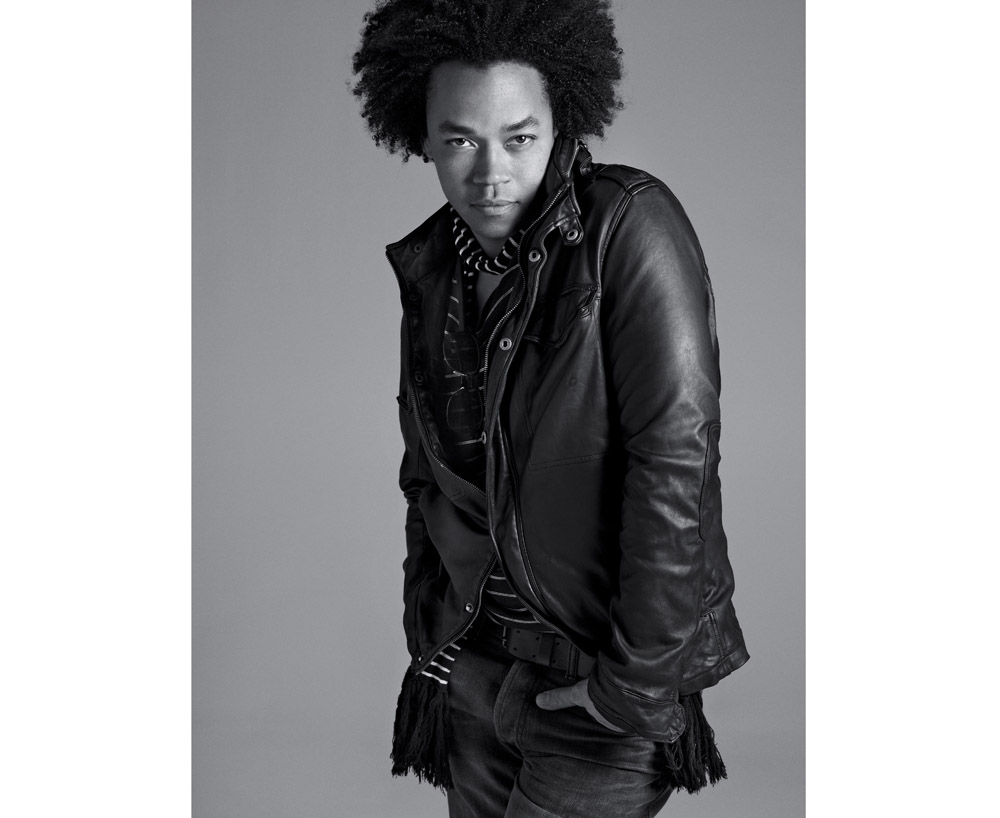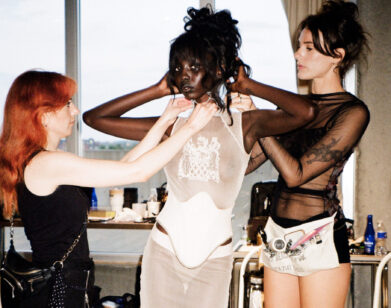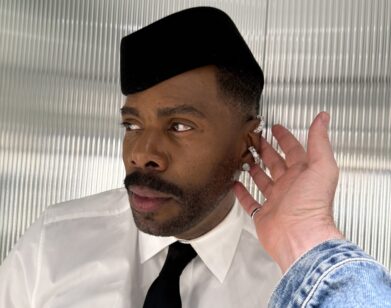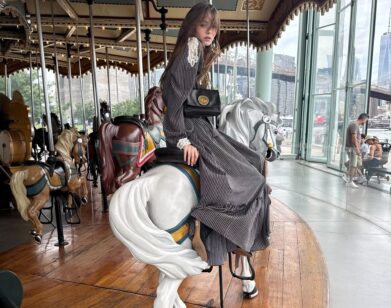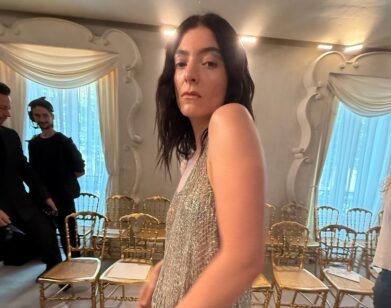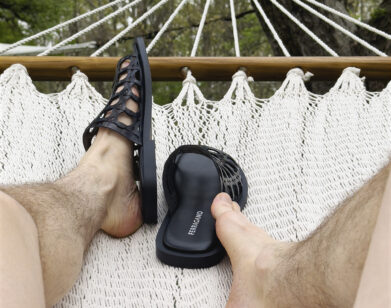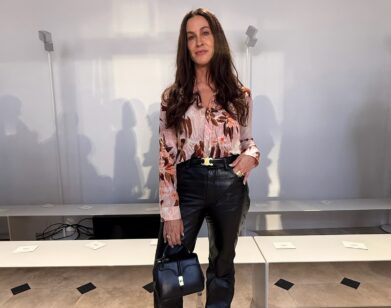Patrick Robinson
As reality TV sage Heidi Klum so famously puts it: In fashion, one day you’re in, and the next, you’re out. These days, Patrick Robinson is in at the Gap, where he’s been executive vice president for the ailing giant since last May. While some people might show the strain of trying to revive the megabrand that dominated the casual clothing market throughout so much of the ’80s and ’90s, Robinson shows no fatigue, instead exuding a laid-back charm characteristic of his Southern California roots. After serving in high-profile positions starting with Armani back in the early ’90s and ending with Paco Rabanne in 2007, the 41-year-old Robinson feels he’s found a home at Gap that returns him to his love of classic American sportswear. Whether he can turn the corporate ship around remains to be seen — his first full collections are for fall 2008-but his sunny, can-do attitude will only help. Really, what could be more all-American than that?
ARIANA SPEYER: Gap has been flailing a bit lately, and you were brought in to revitalize the brand. How did you approach the task? Did you go back to the archives? Did you focus-group?
PATRICK ROBINSON: I didn’t go back to the archives or focus-group. I grew up with Gap — I am the focus group. You’re not coming to Gap to buy a funny fashion ball gown. You’re coming to Gap to find khakis. It’s not like it has to be hard. You grew up with it. I grew up with it. Everyone grew up with it. And we know what it has to be. Just get back to doing that and doing it well. And you’re not going to be fooled-the polo has to fit right, the khakis have to be cool, the fabrics have to be right. That’s Gap.
AS: But fashion consumers these days are jaded. It’s not like it was when Gap started in 1969, before more trend-conscious European chains like H&M and Zara became so dominant. Why do you think Gap can reach people as opposed to all these other brands that are trying to grab their attention?
PR: Well, Gap’s different, because Gap’s not taking fashion from the runway and reproducing it and putting it out there. And there’s nothing wrong with that. All of these brands have figured out that it’s not so much about your brand and its heritage as about servicing a need for fast fashion. Which was cool, because it did make fashion accessible-it created some excitement. It was no longer just these luxury brands that maybe you could buy a bag or a perfume from. But when Gap played in that field, you know, it wasn’t the right field to play in.
AS: So where do you see Gap fitting in?
PR: I see it very clearly that the heritage of Gap is truly thinking about all the classics. You go there to buy a great pair of denim jeans, or khakis, or a peacoat, or a raincoat. I’m going to buy my T-shirts there. I’m going to buy my underwear there. I’m going to buy a great peasant shirt. All the things that we can say are classics that we’ve made new-by making a change in proportion, a change in color, a change in the print, a change in the patterns, and putting it together in an interesting way. You won’t find that at H&M or at Zara or at Target, because they’re playing to a different drummer. We’re serving people, instead of saying, “This is the look, and it’s only going to be cool for six months.”
AS: You’ve been in fashion your whole life, graduating from Parsons in 1989. How did you know this is what you wanted to do?
PR: When I was growing up in Southern California, I started a little surfwear company. I grew up surfing every day, which I wish I could do in New York.
AS: There’s always Rockaway Beach.
PR: Looks cold and the waves are small! I’m a surfer snob. But it was heaven when I was growing up. I’d go before school, during school, after school — but after school was always the best, because you’d paddle out and watch the sun set. I used to go to the Quiksilver warehouse. It was a small, one-story building where you could actually buy shorts. I looked at that and I thought, Oh, I can do that. So I started this cool little surf company, making surf trunks and selling them to all the kids at school.
AS: That’s pretty industrious for a teenager. Did you make the trunks at home?
PR: I sewed them myself. I just did it. So that taught me what I wanted to do and taught me my craft. I always thought I wanted to be a sculptor, because I loved building things. I even sculpted my own surfboards, that sort of thing.
AS: Was that a hard transition, to come to the East Coast?
PR: I didn’t own an overcoat before I went to Parsons. But Parsons was the best choice. I also applied to do premed. My father was a doctor, so I applied thinking that’s what he’d want me to do. He actually talked me out of being a doctor.
I probably need to go lie on a couch somewhere—I’m actually a company man. Patrick Robinson
AS: So he thought being a designer was more practical?
PR: He had always wanted to be an artist. His father actually forced him into being a doctor, because in the early ’60s, as a black man, you weren’t going to let your son be an artist. So my father never really fulfilled his dream. For him it was like, “That’s your dream and go do it.”
AS: You spent part of your early career at Armani, and that’s quite different from what you’re doing now. But hearing about your surfing background, maybe you’ve come full circle in terms of focusing on that casual lifestyle?
PR: There are a few things that have come full circle for me. One is classic clothing. I like making classic sportswear more than I liked even doing Paco Rabanne, which had the whole metal thing, the futurism. There’s something about classic American clothing. So when I got the phone call about Gap, it was perfect. It was a no-brainer. I did grow up a black kid surfing, so I sat in a lot of different little pockets, and that opened my eyes to America. And then moving to the East Coast really put it all into perspective: All of a sudden I had to start dressing in black like a New Yorker. I adore America and all the different parts of it, but then I went farther and got thrown into living in Milan and in Paris for a while. Then you build up that whole international thing and that’s a big part of America, too.
AS: When I was a teenager, I lived in Gap men’s khakis. They were a major part of my very limited wardrobe, along with Chinese slippers and pegged jeans. How do you approach making those classic pieces that people consider essential?
PR: I think if you say it’s easy, you make it easy. That’s what Gap’s all about. Just what you said: You wore a man’s khaki. You make Gap yours. That’s part of my whole thought process. We’ll make a khaki and someone would wear it with the peacoat and a white T-shirt. Someone would wear it just very clean, with maybe a blazer and a button-down shirt. Someone would wear it with a jean jacket and a distressed V-neck T-shirt. Gap’s about having that iconic piece and actually building a wardrobe around it.
AS: What pieces from the fall collection really stand out for you?
PR: The peacoat.
AS: If you guys make a good peacoat, I’ll be very grateful. I’ve been looking for one my whole life.
PR: It’s really, really good. It’s heavy enough to take you through the winter, and it has a good collar that you can stick up when you don’t want to talk to people. [laughs] I think the Pierre Hardy shoes are phenomenal. He took the desert boot and made it his own. It’s not that we’re hiring designers to come in and design a collection of their own for Gap. They’re designing their aesthetic for Gap. It’s playing with a classic element but then putting your own stamp on it, which is different than when Roberto Cavalli does something for H&M. Then, it’s all about Roberto Cavalli.
AS: I love that collection you did for Target, by the way. I read somewhere that that was one of the only times you’ve designed under your own name as opposed to for a brand. At Gap, you’re the idea behind the brand as opposed to the name in front of it.
PR: And I like that a lot. That took me a while to figure out. I like the idea of not being Patrick Robinson, but working for Gap. I probably need to go lie on a couch somewhere — I’m actually a company man. I love the size of this company.
AS: A lot of people might be turned off by a big bureaucracy.
PR: I love the pressure. I love how it all comes together and makes this big umbrella. I love seeing the breadth of it and being the one that helps make sure it all stays on the road and together.
AS: Gap has had a history of spotty manufacturing and bad working conditions. How do you approach that now?
PR: Well, in the early 1990s, Gap, because of their size and their growth over the ’80s, had run into different situations in different countries. So they actually formed an in-house global compliance department. We’re the best out there that do it. We’re making sure our factories are compliant with the way they treat their employees, that they’re in safe working conditions, that they’re getting proper time off. They’re just being treated humanely.
AS: And what about the very popular idea, these days, of creating a company that’s based on principles of sustainability?
PR: We have organic underwear in the store now, but that’s not the whole answer. The big question is: How do you truly start looking at your entire footprint and everything that you’re doing? We’re walking toward that; we’re really not there yet. But when we do it — and I think every company in the world will do it — it’s doing it the right way and with the right intent.
AS: Is that personally important to you?
PR: Yeah, it’s how I live. I don’t eat organically — I eat locally, which is a whole different mentality of living. And whenever I speak to my design team about this, they get excited, because that’s the way they’re beginning to live. That’s why I said I think the whole world has to have that message. But for me, it’s how do you do it honestly, and how do you do it as a corporation.

